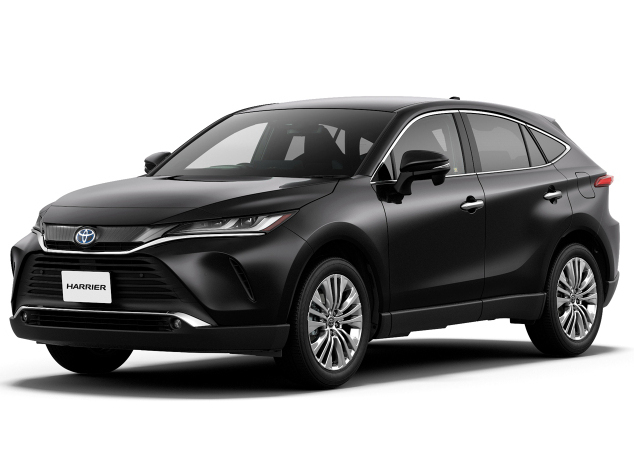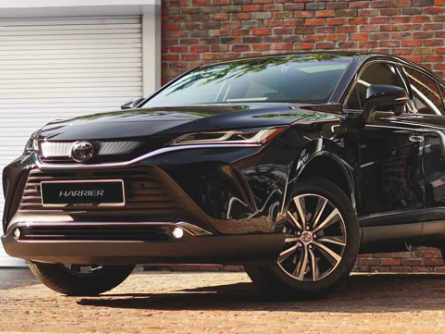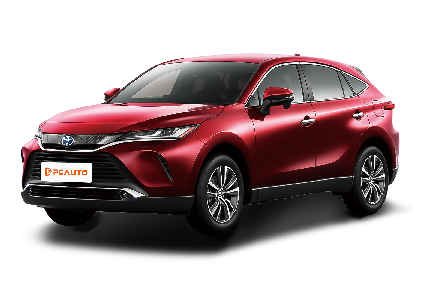Q
What is the Battery Capacity of Toyota Harrier?
The battery capacity of the Toyota Harrier available in the Malaysian market depends on the specific model and powertrain configuration. The hybrid versions usually come with nickel-metal hydride battery packs with a capacity ranging from approximately 1.6 kWh to 2.0 kWh. On the other hand, the pure gasoline-powered models use standard 12V lead-acid batteries, mostly in sizes of DIN 55 or 65 ampere-hours (Ah). For accurate details, it is recommended to refer to the user manual or consult local dealers.
In hybrid models, the battery packs are designed with efficient energy recovery and long-term durability in mind, which can effectively improve fuel economy. As for traditional lead-acid batteries, regular checks of the electrolyte and electrode conditions are necessary to ensure optimal performance.
The hot and humid climate in Malaysia may affect battery life. It is advisable for car owners to have a professional inspection every two years and avoid long-term parking that could lead to battery discharge. Additionally, the battery packs of the hybrid system generally come with a longer warranty period, so you can use them with confidence.
If you need to replace the battery, make sure to choose original or certified parts to ensure compatibility.
Special Disclaimer: This content is published by users and does not represent the views or position of PCauto.
Related Q&A
Q
How many types of Toyota Harriers 2023 are there?
In the Malaysian market in 2023, the Toyota Harrier is mainly available in two models: the Harrier 2.0 with a 2.0-liter naturally aspirated engine and the Harrier Hybrid 2.5 equipped with a 2.5-liter hybrid system. Both models feature front-wheel drive configuration. The Harrier 2.0 is suitable for consumers seeking a smooth driving experience, while the Harrier Hybrid attracts buyers who focus on energy-saving with its higher fuel efficiency and environmental-friendly features.
This fifth - generation Harrier is built on the TNGA-K platform. Its exterior design includes "eagle-eye" LED headlights and a through-type taillight. The interior is equipped with a 12.3 - inch touchscreen and a JBL audio system. The Toyota Safety Sense intelligent safety system comes as standard across the range, including functions such as pre-collision warning and lane-keeping assist.
It's worth noting that all Harriers in the Malaysian market are completely built-up (CBU) imports, so the prices are slightly higher than those of completely knocked - down (CKD) locally assembled cars. However, this also ensures the original factory quality. For consumers considering purchasing, it is recommended to choose the power version based on their daily driving mileage. If you often drive long distances, the hybrid version can significantly reduce fuel costs, while the 2.0 - liter version offers better cost - effectiveness for short - distance urban commuting.
Q
What is the life expectancy of a Harrier 2023?
In 2023, the normal service life of the Toyota Harrier in Malaysia can reach 15 to 20 years or cover a mileage of over 250,000 kilometers. The specific lifespan depends on maintenance conditions, driving habits, and road and environmental conditions. Regularly replacing key consumables such as engine oil, transmission fluid, and brake fluid and following the manufacturer's maintenance manual can significantly extend the vehicle's lifespan. As a mid - size SUV under the Toyota brand, the Harrier has a good reputation for its durability, thanks to its mature powertrain and reliable chassis design. The tropical climate in Malaysia has a certain impact on rubber parts and electronic components. It is recommended that car owners check the condition of suspension bushings and wiring harnesses every two years. At the same time, pay attention to anti-rust treatment of the chassis during the rainy season. For the hybrid version, special attention should be paid to the maintenance of the battery cooling system. Good driving habits, such as avoiding frequent rapid acceleration and hard braking, can also reduce mechanical wear. It's worth noting that there is a strong demand for well - maintained Harriers in the Malaysian used-car market, and they have a relatively high residual value. If you plan to use the vehicle for a long time, it is recommended to choose the original factory's extended warranty service for more comprehensive protection.
Q
Is the 2023 Toyota Harrier a 5 seater or 7 seater?
The 2023 Toyota Harrier in the Malaysian market is a 5-seater SUV, and no 7-seater version is available. This model focuses on luxury and comfort, featuring a two-row seat layout, which is suitable for family or individual users who pursue a refined driving and riding experience. As a mid-size SUV under Toyota, its body size and design emphasize rear-seat space and trunk practicality rather than a multi-seat configuration. If you need a 7-seater vehicle, you can consider other Toyota SUVs like the Fortuner or Innova. When Malaysian consumers choose an SUV, apart from the number of seats, they also need to consider the power configuration (for example, the Harrier offers 2.0L naturally aspirated and 2.5L hybrid options), fuel economy, and adaptability to local road conditions. The hybrid version of the Toyota Harrier is especially suitable for urban commuting, balancing performance and fuel consumption. Moreover, the automotive tax structure in Malaysia gives hybrid models a price advantage, which is also one of the reasons why the Harrier is popular locally.
Q
What is the safety rating of Harrier 2023?
In 2023, the Toyota Harrier excelled in terms of safety performance. According to the test results of the globally authoritative safety evaluation organization, ASEAN NCAP, this model received a 5-star safety rating. This rating covers multiple aspects such as adult occupant protection, child occupant protection, and safety assistance technologies, indicating its high standards in collision safety and active safety configurations.
The 2023 Harrier is equipped with Toyota's latest TSS (Toyota Safety Sense) active safety system, including functions like the pre - collision system, lane - keeping assist, and adaptive cruise control. These technologies can effectively enhance driving safety and reduce the risk of accidents. For Malaysian consumers, choosing a vehicle with a high safety rating is particularly important because the road traffic conditions in Malaysia are complex, and the safety performance of a vehicle is directly related to the lives of drivers and passengers.
In addition, the 2023 Harrier also features a high-rigidity body structure and multiple airbags, which further enhance passive safety protection. Understanding a vehicle's safety rating and configuration is an important reference when purchasing a car. It is recommended that consumers thoroughly understand relevant safety test reports and actual driving experiences before buying a car to ensure they choose the model that best suits their needs.
Q
What is the eco mode on a Toyota Harrier 2023?
The ECO mode of the 2023 Toyota Harrier is a driving assistance feature designed to improve fuel economy. It optimizes energy consumption by adjusting the engine output, the gear - shifting logic of the transmission, and the power consumption of the air - conditioning system. This mode is particularly suitable for the common urban congested traffic conditions in Malaysia.
When the ECO mode is activated, the vehicle reduces fuel consumption with a smoother acceleration response and an early up-shifting strategy. Meanwhile, the dashboard shows real-time energy-saving feedback to help drivers develop fuel-saving habits. This mode works in tandem with the Dynamic Force series 2.0L naturally-aspirated or 2.5L hybrid system equipped in the Harrier. The hybrid version can manage the alternation between the electric motor and the engine more efficiently in ECO mode.
For drivers who often face the morning and evening rush hours in Kuala Lumpur, the ECO mode can significantly reduce fuel consumption by about 10% - 15%. However, it should be noted that the power response may be temporarily weakened during sudden acceleration or on steep slopes. Similar features are also provided by models in the same class, such as the ECON mode of the Honda CR-V or the i-stop technology of the Mazda CX-5, but Toyota's hybrid system has an edge in energy management.
It is recommended that Malaysian car owners activate the ECO mode first when driving on long - distance trips or flat roads. When quick overtaking is needed or when driving on mountain roads, they can switch to the normal mode for a more direct power output.
Q
Is the 2023 Toyota Harrier a SUV or MPV?
The 2023 Toyota Harrier is an SUV (Sport Utility Vehicle), not an MPV (Multi - Purpose Vehicle). This vehicle is well- known for its stylish exterior design, high ground clearance, and comfort that caters to city driving. It's a great fit for Malaysian families, offering an excellent driving experience on both city roads and during occasional out-of-town trips.
The main differences between SUVs and MPVs lie in their body structures and uses. SUVs generally focus on driving visibility and off - road capability, while MPVs prioritize passenger space and seating capacity. As a five-seat SUV, the Harrier provides decent trunk space and elevated seat positions, making it a good choice for consumers who like the SUV style but don't want a large seven-seat model.
In the Malaysian market, the Harrier has become a popular option among many car buyers, thanks to the reliability of the Toyota brand and the fuel efficiency of its hybrid version, especially for those who seek both comfort and practicality. Moreover, it comes with a rich array of safety features, including Toyota's latest TSS (Toyota Safety Sense) system, which further enhances driving safety.
Q
Does 2023 Harrier have turbo?
In 2023, the versions of the Toyota Harrier available in the Malaysian market are indeed equipped with turbo-charged engines. Specifically, it's a 2.0-liter turbo-charged four-cylinder engine. This engine can deliver a power output of approximately 227 horsepower and a torque of 350 Nm, with quite excellent performance. Meanwhile, the car also offers a 2.5-liter naturally aspirated hybrid version, which is suitable for consumers who pursue fuel economy.
Turbocharging technology improves the engine's intake efficiency by compressing air, thus enhancing power without increasing the displacement. This technology is becoming more and more popular in modern cars, especially when it comes to meeting the requirements of both performance and environmental protection. For Malaysian consumers, choosing the turbo-charged version of the Harrier not only allows them to enjoy more powerful performance but also experience more responsive acceleration, which is very suitable for city driving and high-speed cruising.
In addition, Toyota's turbo-charged engines have a good reputation for reliability and durability, and the maintenance costs are relatively reasonable, making them suitable for long - term use. If you have high requirements for power, the turbo-charged version of the Harrier would be a good choice, while the hybrid version is more suitable for drivers who focus on energy conservation and environmental protection.
Q
What is the top speed of the Toyota Harrier 2023?
In 2023, the official maximum speed of the Toyota Harrier in the Malaysian market is approximately 180 km/h. This figure applies to the front-wheel drive or all - wheel drive versions equipped with a 2.0-liter naturally aspirated engine (171 hp). As for the hybrid models (2.5 liters + electric motor, with a combined output of 218 hp), due to the tuning of the powertrain and the setting of the electronic speed limit, their top-speed performance is similar.
It's worth noting that the actual top speed may be affected by factors such as road conditions, vehicle load, and climate. In the hot and humid environment of Malaysia's tropical rainforest climate, it is recommended that car owners regularly check the cooling system and tire condition to ensure safety during high - speed driving.
As a mid - size SUV focusing on luxury and comfort, the electronic speed-limit setting of the Harrier pays more attention to fuel economy and driving stability. The Toyota Safety Sense system it is equipped with will automatically optimize power output and braking assistance at high speeds.
If you have higher performance requirements, you can refer to the top - speed performance of peer models such as the Honda CR - V or the Mazda CX-5. However, it should be noted that the high-center-of-gravity design of SUVs inherently results in a lower speed limit compared to sedans in the same class.
It is recommended that car owners experience the top speed on legal race tracks or closed venues. The default speed limit on Malaysian highways is 110 km/h. Speeding is not only illegal but also significantly increases fuel consumption.
Q
Is 2023 Harrier 3 cylinder or 4 cylinder?
The 2023 Toyota Harrier available in the Malaysian market has a gasoline version equipped with a 2.0-liter four-cylinder naturally aspirated engine (model 3ZR-FAE), while the hybrid version features a combination of a 2.5-liter four-cylinder Atkinson cycle engine and an electric motor. Therefore, both the gasoline and hybrid versions come with a four-cylinder configuration, not a three-cylinder design. For Malaysian consumers, four-cylinder engines usually have an edge over three-cylinder ones in terms of smoothness and noise control. Meanwhile, Toyota's Dynamic Force series engines are well - known for their high thermal efficiency, which can balance power and fuel economy. It's worth noting that although there is a global trend in the automotive industry to reduce engine displacement and the number of cylinders, Toyota still adheres to the four - cylinder foundation in its mainstream SUV models to ensure driving quality and reliability. Three - cylinder engines are more commonly found in small cars or entry - level models. It is recommended that you take a test drive at an authorized dealer before buying a car to experience the performance differences of different powertrains in person.
Q
How much is Toyota Harrier 2023?
In 2023, the price of the Toyota Harrier in Malaysia ranges from approximately RM 249,706 to RM 277,426 depending on the model and configuration. The specific price may fluctuate due to regional dealer discounts or optional accessories. This vehicle is equipped with a 2.0-liter naturally aspirated or a 2.5-liter hybrid powertrain, offering both front-wheel drive and all-wheel drive versions. It is favored by local consumers for its luxurious interior, advanced safety features (such as Toyota Safety Sense), and smooth driving experience.
It's worth noting that as a completely built-up (CBU) imported vehicle, the price of the Harrier is affected by exchange rates and import duties. Moreover, the hybrid version can enjoy some tax incentives from the Malaysian government for energy-efficient vehicles (EEV). If you're considering Japanese SUVs in the same class, you can also refer to models like the Honda CR-V or Mazda CX-5. However, the Harrier has an edge in terms of luxury thanks to its higher positioning and more comprehensive configuration.
It is recommended that you check the latest price quotes on the official Toyota Malaysia website before purchasing and take a test drive at an authorized dealer to experience its actual performance.
Latest Q&A
Q
Which Volvo XC90 model is best?
In the Malaysian market, the best choice of the Volvo XC90 depends on individual needs. However, considering the comprehensive performance and configuration, the XC90 Recharge T8 Plug - in Hybrid is the most recommended model. It combines a 2.0 - liter turbocharged engine with an electric motor, offering a powerful 407 - horsepower output and low fuel consumption. It has an all - electric range of about 50 kilometers, which is suitable for daily short - distance commuting. At the same time, it retains Volvo's iconic safety technologies such as the City Safety urban safety system and Pilot Assist intelligent driving assistance.
If you have a limited budget, the B5 Mild Hybrid is also a practical option. It is equipped with a 2.0 - liter turbo engine with 250 horsepower and a 48V mild - hybrid system, balancing power and fuel economy. Malaysian users should note that the T8 version can enjoy tax incentives for new energy vehicles from the local government, resulting in lower long - term usage costs. The B5 version, on the other hand, is more suitable for areas with inconvenient charging facilities.
The entire Volvo XC90 series comes standard with a 7 - seat layout and a luxurious interior. The materials are environmentally friendly, and it is equipped with a 9 - inch touchscreen, making it suitable for family users. It is recommended that you choose according to your actual driving scenarios and budget, and go to an authorized dealer for a test drive.
Q
What size engine is in the Volvo XC90 T5?
The Volvo XC90 T5 is equipped with a 2.0-liter four-cylinder turbocharged gasoline engine. This engine belongs to the Volvo Drive-E series, with a maximum output power of 250 horsepower and a peak torque of 350 Nm. It is paired with an 8-speed automatic transmission, offering a smooth and efficient driving experience. For Malaysian consumers, this engine combines good power performance with excellent fuel economy, making it suitable for both city driving and long-distance travel. It's worth mentioning that the Drive-E engine series from Volvo features a modular design, which not only reduces weight but also optimizes emission performance, meeting the increasingly strict global environmental standards. In the Malaysian market, the XC90 T5 is targeted at buyers who desire a luxury SUV but don't want a large-displacement vehicle. Its power output is sufficient for daily needs, and the maintenance cost is relatively low. Moreover, Volvo's leading edge in safety technology also adds significant value to the XC90 T5. For example, the standard City Safety system can effectively enhance driving safety.
Q
Does the XC90 T5 have enough power?
The Volvo XC90 T5 is equipped with a 2.0-liter four-cylinder turbocharged engine, with a maximum power of 254 horsepower and a peak torque of 350 Nm. This kind of power configuration is sufficient for daily driving and highway cruising. Especially on the urban roads and highways in Malaysia, it can provide a smooth and responsive driving experience. Although the T5 is the entry-level power version in the XC90 lineup, its power output can already meet the needs of most families and businesses. Especially in the congested urban areas of Kuala Lumpur or during long-distance drives, its fuel consumption is also relatively economical. If you have higher requirements for power, you can consider the T6 or T8 plug-in hybrid versions, which offer stronger power and a wider range of driving modes. Overall, the XC90 T5 strikes a good balance between power and practicality, making it suitable for Malaysian users who value comfort and fuel economy.
Q
What engine is in the Volvo XC90 T5 2020?
The 2020 Volvo XC90 T5 is equipped with a 2.0-liter four-cylinder turbocharged gasoline engine. The maximum output power reaches 250 horsepower, and the peak torque hits 350 Nm. It's paired with an 8-speed automatic transmission and comes with either front-wheel drive or all-wheel drive. This engine belongs to the Volvo Drive-E series, which is well - known for its high efficiency and environmental friendliness, meeting the Euro 6 emission standards.
For Malaysian consumers, the power performance of the XC90 T5 is more than enough for daily driving and long - distance trips, while also taking fuel economy into account. It's a great fit for family users who value both practicality and luxury.
It's worth mentioning that the Drive - E engine family by Volvo features a modular design with high technical sharing. This means the maintenance costs are relatively controllable, and original - factory technical support can be obtained at authorized service centers in Malaysia.
The higher - performance T6 version in the same series adds a supercharger, and the T8 plug - in hybrid version further combines electric technology, demonstrating Volvo's technical accumulation in diversifying powertrain systems. Consumers can choose different configurations according to their budgets and needs.
Q
Is the 2023 BMW M2 Coupe manual?
In 2023, the BMW M2 Coupe indeed offers a manual transmission option (6-speed manual). This is a design retained by BMW to meet the needs of driving enthusiasts for the pure pleasure of control. Meanwhile, it is also equipped with an 8-speed automatic manual transmission for consumers to choose from. This car is powered by a 3.0-liter inline-six twin-turbocharged engine with a maximum output power of 453 horsepower. Its performance is very impressive, especially suitable for the winding roads and high-speed driving environment in Malaysia. For Malaysian car fans, the manual version can provide a more direct driving involvement, while the automatic version is more suitable for congested urban traffic. As a high-performance compact coupe, the BMW M2 Coupe has received high praise for its handling and power performance. Its chassis tuning and power output are very suitable for owners who love the joy of driving. In addition, the hot and rainy climate in Malaysia places high demands on vehicle heat dissipation and tire performance. The cooling system and tire configuration of the M2 Coupe can well handle these challenges, ensuring the vehicle remains stable during intense driving.
View MoreRelated News

Toyota Harrier: The Perfect Blend of Fuel Efficiency and Premium Comfort
JamesApr 23, 2025

The 2023 Toyota Harrier is priced at RM 274,000, 2.0NA+CVT
LienJul 3, 2024

2026 Toyota Land Cruiser released in North America, offering the 1958 edition as a tribute to history
JohnSep 15, 2025

Toyota Corolla facelift model unveiled, the new front design looks like Camry
JamesSep 11, 2025

2025 Toyota Aqua Released, Fuel Efficiency 35.4km/L, More Worth Buying Than Corolla
Kevin WongSep 3, 2025
View More


















Pros
Cons